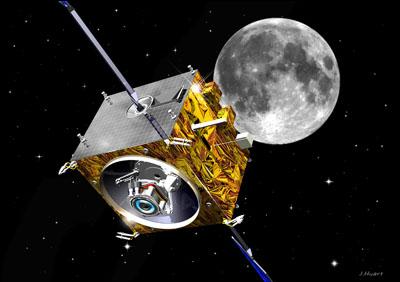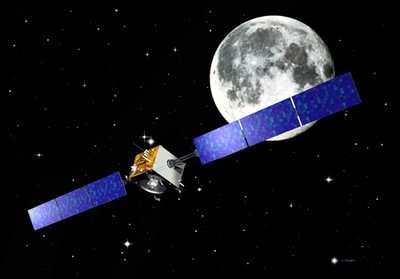European Moonshot Yielded Valuable Data
As ANN reported one year ago,
Europe reached the Moon for the first time as scientists on Earth
eagerly watched SMART-1's spectacular impact. The European Space
Agenct says results from the impact analysis and from the
instruments still keep coming, one year after SMART-1's September
3, 2006 lunar impact.

ESA recently presented ongoing scientific highlights of the
mission. The analysis of data and simulations of the satellite's
impact provide clues on the dynamics of the ejecta after the flash,
along with laboratory experiments or modelling of impacts. The
experience gained is being put to good use in preparation for
future missions.
ESA says SMART-1 addressed various scientific themes, which
answer questions on the physical processes at work on Earth-like
planets and how they evolve. The moon is a laboratory for
geophysics where impacts, volcanism, tectonics and effects of space
weather can be studied to put together the story of its past. The
geochemistry and origins of the Moon, the evolution of the
Earth-Moon system and the bombardment of the inner solar system are
topics addressed under lunar formation and evolution.
Know-how from SMART-1 is helping prepare the ground for future
science and exploration missions. ESA says the satellite has mapped
the polar regions, surveyed lunar resources and investigated
potential landing sites and outposts.

More than 15 presentations were given by the SMART-1 team during
the 'Europlanet' European Planetary Science Congress in Berlin,
August 20-24. Topics covered included highlights of SMART-1 lunar
science, new results on coupling between impacts and lunar
volcanism for Humorum and Procellarum basins, latest high
resolution maps of the lunar Poles and infrared spectra of lunar
areas and craters.
 Mike Burchell from the University of
Kent showed laboratory simulations describing the impact crater's
shape and size, predicting ricochet ejecta. As a detailed picture
of the impact is taking shape, scientists now know that the
spacecraft bounced over the surface, projecting debris at high
altitude, which was traced by Christian Veillet with the Canada
France Hawaii telescope.
Mike Burchell from the University of
Kent showed laboratory simulations describing the impact crater's
shape and size, predicting ricochet ejecta. As a detailed picture
of the impact is taking shape, scientists now know that the
spacecraft bounced over the surface, projecting debris at high
altitude, which was traced by Christian Veillet with the Canada
France Hawaii telescope.
Experts from the SMART-1 team are now working on data
calibration, analysis, archival and distribution for the scientific
community and are supporting collaborations with upcoming lunar
missions. This includes refining the lunar coordinate systems,
selecting targets observed by SMART-1 and other probes, exchanging
tools for scientific planning, or building on SMART-1 outreach or
education activities to promote future lunar missions and
exploration.
"Know-how and data from SMART-1 is forming a bridge for
international collaboration and European contribution to upcoming
lunar Missions," says SMART-1 Project scientist Bernard Foing.
Chang'E-1, China's lunar orbiter and JAXA's Selene are ready to
be launched later this year. In Spring 2008, the Indian
Chandrayaan-1 will carry three ESA instruments (two of them
upgraded SMART-1 X-ray and infrared instruments) to observe the
moon.

Knowledge gained from SMART-1 and the impact campaign is also
helping the preparation of NASA's Lunar Reconnaissance Orbiter and
the Lunar Crater Observation and Sensing Satellite, due for launch
before the end of 2008. SMART-1's high resolution maps are helping
characterise future landing sites, in particular at the poles.
"After SMART-1's final touchdown at 2 km/s," says Bernard Foing,
"everybody asks: when will Europe land softly on the Moon?"
 ANN's Daily Aero-Linx (04.16.24)
ANN's Daily Aero-Linx (04.16.24) Aero-News: Quote of the Day (04.16.24)
Aero-News: Quote of the Day (04.16.24) Airborne 04.10.24: SnF24!, A50 Heritage Reveal, HeliCycle!, Montaer MC-01
Airborne 04.10.24: SnF24!, A50 Heritage Reveal, HeliCycle!, Montaer MC-01 Airborne 04.12.24: SnF24!, G100UL Is Here, Holy Micro, Plane Tags
Airborne 04.12.24: SnF24!, G100UL Is Here, Holy Micro, Plane Tags Airborne-Flight Training 04.17.24: Feds Need Controllers, Spirit Delay, Redbird
Airborne-Flight Training 04.17.24: Feds Need Controllers, Spirit Delay, Redbird






